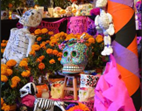Activity 22: Death, Diversity, and Heritage
Overview of the activity
Participants will investigate culture and cultural heritage by studying and discussing death rituals and visiting a cemetery.
Objectives
- To understand the link between culture and death.
- To learn to use the cemetery as a field to explore cultural diversity.
| Duration (in minutes) | Min/max number of participants | |
A maximum of 110–115 minutes divided between:
|
|
| Minimum knowledge requirements of participants | Materials needed | Preparation |
| A common language is necessary to guide the activity interactively. If this is not possible, participants can help out each other with translation. |
|
Make your selection of the statements for the circle game (see proposed list of statements below).
If you carry out the activity in a cemetery, choose a cemetery that is ‘multicultural’, i.e. that has graves of people of different religions and belief systems. If there are graves from different time periods, that is also an advantage. If you carry out the activity indoors, you will need to select and print photos (preferably A4 size). Make the selection based on the cultural rites and practices that you can find sufficient information about to share with participants. |
Room/space requirements
-
- Step 5 of the activity can be proposed in a cemetery (we tested it in Père Lachaise cemetery in Paris) or indoors.
- When carried out in a cemetery, choose a larger free space for the introduction activity. For the debrief, try to find a place where participants can sit down.
- When carried out indoors, you need a space that allows the circle game (participants to stand in a circle comfortably) and space to hang images on the wall and participants to view them as if they were in an exhibition.

Instructions
- Get to know each other. If the group is new, to facilitate trust and to start building connections, propose a pair exercise, inviting participants to pair with someone they do not know. Ask them to share material or immaterial heritage from their own cultures connected to death that is important to them (5 minutes). Alternatively, they could talk about where or how they would like to die; where and how they would like their body to be treated after their death.
- Another introductory exercise is the circle game, which is in fact a circle-shaped adaptation of the opinion line. Start by reading out a set of statements that are related to death and that can be answered YES or NO. When participants agree with the statement, they should move towards the centre of the circle to the extent that they agree. Those who disagree do not move forward. After participants respond in this way to a statement, ask them to look at who is inside the circle and who is on the outer perimeter. Then ask them all to move back to the perimeter. Below, is a proposal for statements that you might choose from and freely adapt:
- I am scared of death
- I think a lot about death
- To have a good relationship with death it is necessary to have a good relationship with life
- I go to the cemetery regularly for my ancestors (once a month? once a year?)
- I like to visit cemeteries
- If it was possible, I’d like to live forever
- I think death is really the end
- Death is a transformation
- I believe in an afterlife
- Talking to dead ancestors is important (possible)
After a first set of statements, you might give participants the opportunity to propose some statements of their own.
- The next step is an activity that confronts participants with different rituals and practices related to death. We invite participants to look at diverse images (see below) and choose the one that they find the most intriguing or even shocking. Hopefully, 2–3 people may have chosen the same image, so you can create small groups around the images.
- Invite participants to discuss (without any pressure to agree) how the image makes them feel, what visible element in the image provoked that feeling and what values of their own – i.e. what is important for them – could have triggered these emotions. To close, ask participants what they discovered about themselves – their own representations, expectations, ideas concerning death. Indeed, this step of the activity – despite appearances – is not about ‘other’ cultures, but about ourselves.
- The final step of the sequence is an ‘exploration’ activity in a cemetery, for which you can ask participants to form groups of 3 or maximum 4 people. Before creating the subgroups, give them the instructions. Their job is to become explorers and spot as many different patterns as possible. Check that the concept of ‘pattern’ makes sense to everybody. You can propose the following definition:
‘Patterns’ are regularities, repetitions, signs of social organization or social structure. They suggest collective meaning, as opposed to random occurrence. As such, they are the indicators that we are witnessing ‘cultural’ behaviour or ‘cultural heritage’ as opposed to signs of individual action.
- The mission in the cemetery is to observe visible differences, organize them in a structural way and then try to understand what they can tell us about different people’s relationship to death. Offer each group an ‘observation sheet’ (see below) and ask them to try to fill it out as best they can. Encourage them to find new patterns, even if not all the lines can be filled in: sometimes the gaps are significant too!
- To debrief together go through the observation grid, check the differences observed and considered the explanation for this. Each time, ask participants whether they are aware of further differences related to each of the patterns observed – even if that difference was not represented in the cemetery.
Learning outcomes / evidence collected
Complementary material
Below, you can find our proposed observation grid. To start, only the first column should be completed. We only completed the second column to give you some indication as to what types of differences might be observed. In column three, participants are free to make hypotheses about what they think explains the differences observed. Again, as an indication, we propose some questions that you can ask participants.
| Type of patterns | Differences observed | Possible explanations, questions |
| What do visitors to the dead bring for them? | Flowers, stones, toys, etc. | Who brings flowers? Who brings stones?What is the meaning of ‘visitation stones’ in the Jewish religion?
Where does the tradition of bringing flowers originate? What is its meaning? |
| What is buried or placed in the grave? | Body, ashes, nothing. | Do we know of any cultural prescriptions concerning cremation? |
| What information is shared on the gravestone? | Name, date of birth and death, reasons for death, a citation, number of concessions, etc. | |
| What size is the grave? | Big, small? | |
| What form does it take? | Small mausoleum, grave | |
| Do the graves have specific orientation? | No specific orientation, head positioned towards Mecca | |
| What type of decoration does it have? | ||
| What do visitors do, how are they dressed? |
Evaluation
Teaching tips, stories and experiences during piloting
As an introduction, ask participants what connections they see between ‘culture’ and ‘death’. Most likely, they will tell you that there are many ‘cultural rituals’ or ‘religious rites’ concerning death and the treatment of dead people.
If you cannot carry out Step 5 in a cemetery, you can adapt the activity for an indoor space. In this case, you should continue to work with the images used in Steps 3-4. The focus of the activity will be the same – to try to develop a deeper understanding of cultural difference – but in this case you can do it through working with just one image. With the group, choose the image that appeared the most intriguing in the previous step. Discuss these four questions with participants:
- How can we know whether it is a cultural practice or a strange instance of individual behaviour?
- What patterns would we need to observe to answer the previous question?
- What questions would you ask the people practising that ritual?
- After this reflection do you have any hypotheses on the cultural practice? What does the practice serve? Why does it exist?
Additional resources
To carry out the activity indoors, make a selection of interesting images. We propose some options below, but feel free to make your own selection. We recommend looking for illustrations of:
- France: streets of elaborate stone crypts
- Indonesia (Sulawesi) ‘Manene’ ritual: ancestors taken out of the coffin to clean, dress, take pictures, etc.
- Vietnam: graves in the rice field
- Mexico: day of the dead
- US: exposing a dead person with make-up in a coffin
- Philippines: bringing food to the cemetery during the All Saints’ period
- Zoroastrians: tower of silence
- North America, Europe: Pet cemeteries
 |
 |
 |
 |
